Whether I just want to “chat” with friends nearby, or connect with distant stations on another continent – CB radio can offer both. But what actually influences the range of CB radio? We’ll clarify that here.
It’s difficult to say which of these factors is the most important, as almost all influence each other. And in all cases – “RF and love travel in strange ways.” Sometimes even with maximum power you can’t reach the next village, other times you can reach South America with just 1 watt. Why is that?
The Propagation Conditions of Radio Waves
The physics of radio waves has been an active area of research since their discovery over 100 years ago. Even today, not all effects are fully understood and therefore only partially predictable. The propagation of radio waves depends heavily on frequency. For CB, we’re talking about frequencies in the upper shortwave range, at 27 MHz. For this shortwave range, there are two possible propagation paths: ground wave and sky wave.
The Ground Wave
The ground wave propagates along the Earth’s surface. It is subject to strong attenuation because the ground, rocks, etc. are poor electrical conductors. This strongly limits the range to a few or a few dozen kilometers. The actual range achieved with ground wave propagation depends essentially on the transmitting power, the terrain, and the antenna location or the antenna itself. However, there are physical limits – even with extremely high transmitting power and a perfect antenna, you eventually can’t go any further.
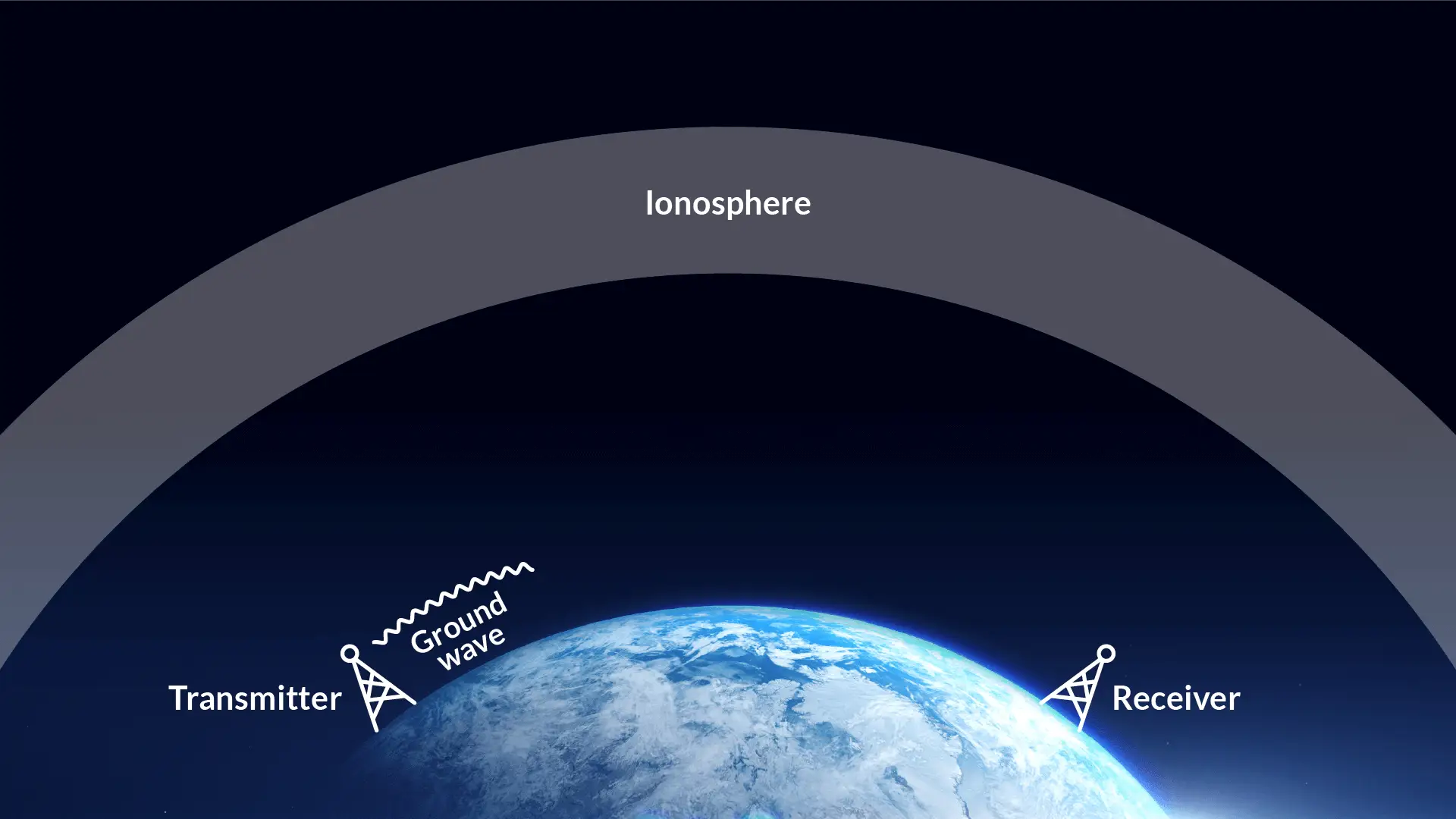
But sometimes this limited range is exactly what you want. When talking with friends from the local club, signals from great distances can be just as disruptive as interruptions from a thunderstorm.
The typical range of the ground wave for CB radio is approximately 5 to 30 km, depending on conditions.
The Sky Wave
The sky wave, on the other hand, follows completely different rules and can provide contact over several thousand kilometers, even with moderate transmitting power. The radio waves emitted by the antenna don’t just move along the Earth’s surface but also spread upward. How strongly this occurs depends on the type of antenna and its setup.
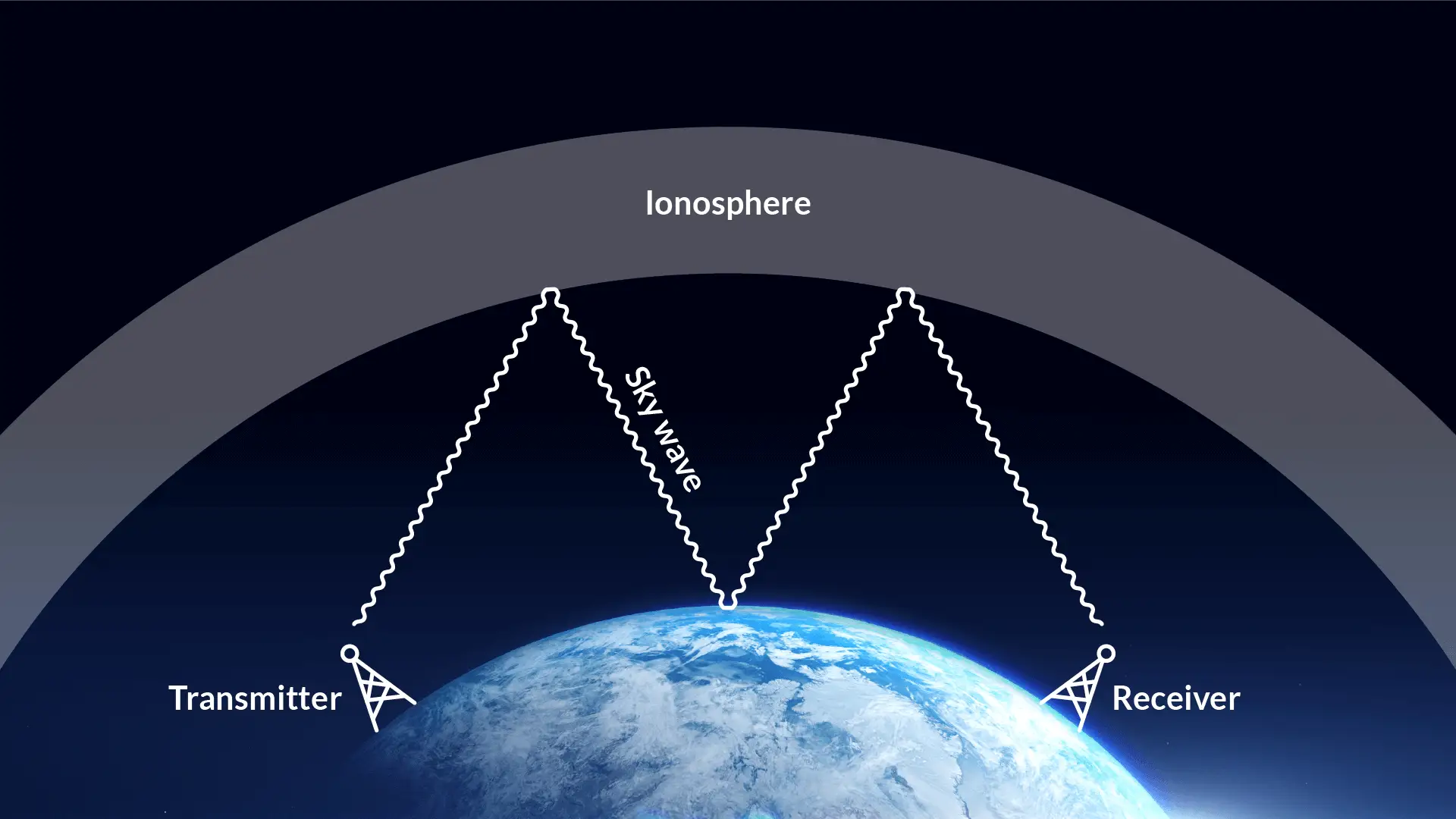
On their way upward, the radio waves eventually encounter reflecting areas of the ionosphere surrounding our planet. The ionosphere is the region far above the atmosphere, from heights of about 80 to 400 km. The name comes from the process of “ionization” that takes place there. This is the physical effect where a molecule is “freed” from its electrons by strong radiation. While the molecule was electrically neutral with electrons before, after losing its outer electron shell, it becomes electrically positively charged.
And this “ionization” is exactly what reflects radio waves. Strictly speaking, it’s not reflection but diffraction and refraction, phenomena well known from optics.
Sunrays Clear the Way
Where does the radiation that ionizes molecules come from? From the sun! Our central star produces unimaginably large amounts of energy every second, a significant portion of which arrives here as radiation. Fortunately, the ionosphere and atmosphere protect us from the harmful effects of this radiation. At great heights, this energy acts unhindered and thus – under certain circumstances – causes the ionization of air molecules present there. These “circumstances” are very complex. The degree of ionization depends on the density of air molecules, the activity of the sun, the angle at which solar radiation hits the Earth, etc.

The overall effect of the sky wave is thus given by a reflection of radio waves at heights of 80 to about 400 km. These reflections are not sharply defined and also change over time. When they exist, a radio signal can be reflected and mirrored back to the Earth’s surface. And there? Reflected upward again, hitting a reflecting layer in the ionosphere again, directed downward, and so on. After approximately 7 such “hops,” you’ve gone around the world, creating worldwide radio traffic on shortwave.
For the frequency range of CB radio at 27 MHz, there is quite frequently a situation during high solar activity where reflecting layers form at about 80-100 km in height, the so-called E-layer. Due to the relatively low height, the range is limited to about 2000 – 3000 km; rarely are there propagation phenomena over multiple hops. However, the reflection strength is very good, making perfect connections possible even with very low power of just a few watts. On such days, we hear taxi radio from Moscow as clearly as the neighbor three streets away. These effects sometimes occur very briefly, sporadically, which is why this phenomenon of the sky wave is also called Sporadic-E.
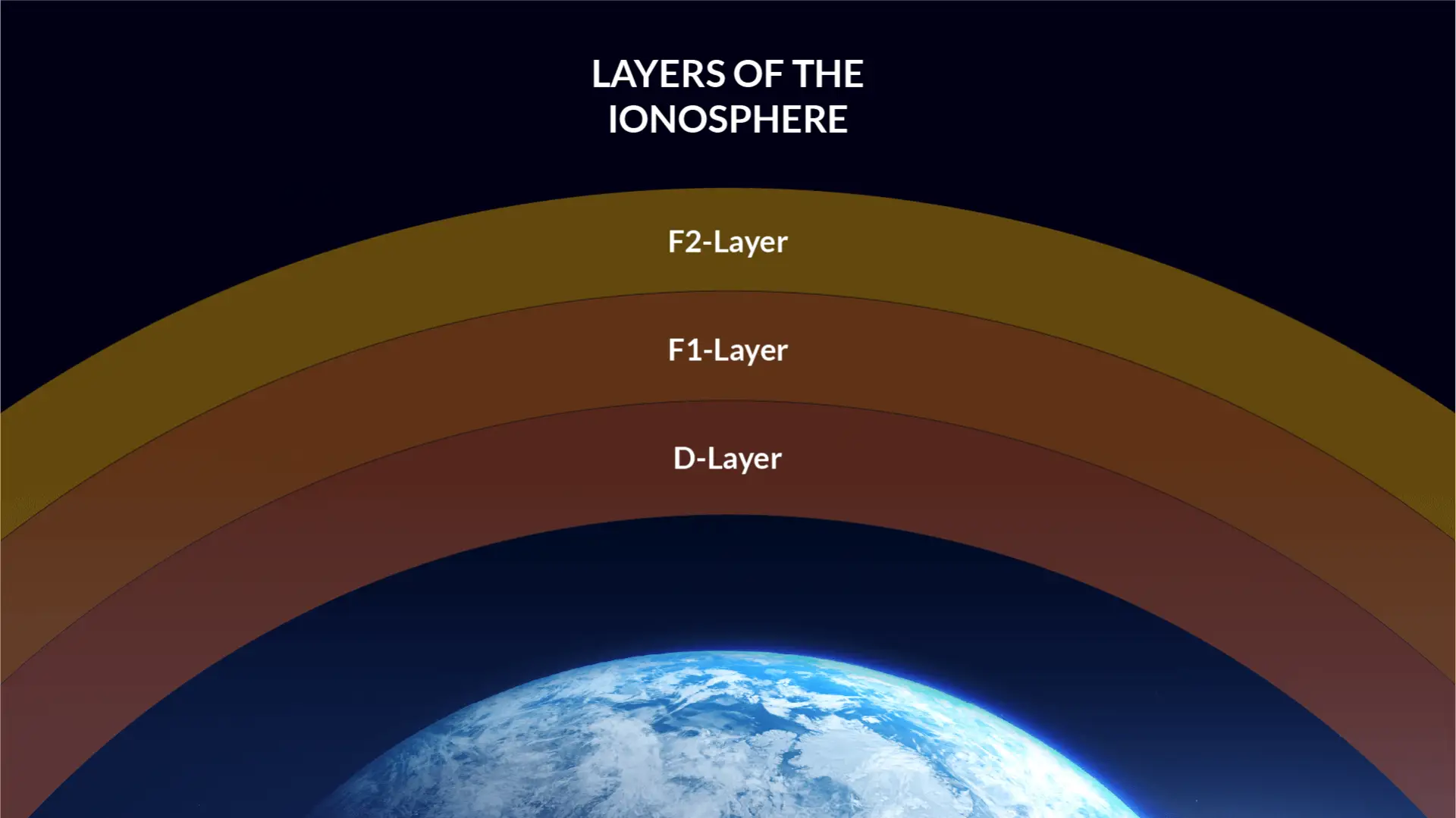
Other effects of reflection at great heights (the so-called F-layers) also exist, but much more rarely and usually only during times of high solar activity. And there are effects whose causes are still not completely clear, such as the so-called Trans-Equatorial Propagation (TEP), which often provides CB radio with excellent signals from north to south, for example from Europe to South America.
What Actually Determines How Far You Can Transmit?
Let’s summarize. The ground wave reaches about 5 to 30 km, depending on the antenna and location. The sky wave reaches approximately 400 to 2-3000 km, in rare cases even further. The sky wave is heavily dependent on solar activity, while the ground wave is not. And as always – without a good, free-standing antenna, hardly anything works.
When Your Signal Simply Disappears Without a Trace
The area where the ground wave no longer reaches and where the sky wave hasn’t yet reached is called the “skip zone.” In this ring-shaped zone around my location, my signal cannot be heard, even at maximum power.
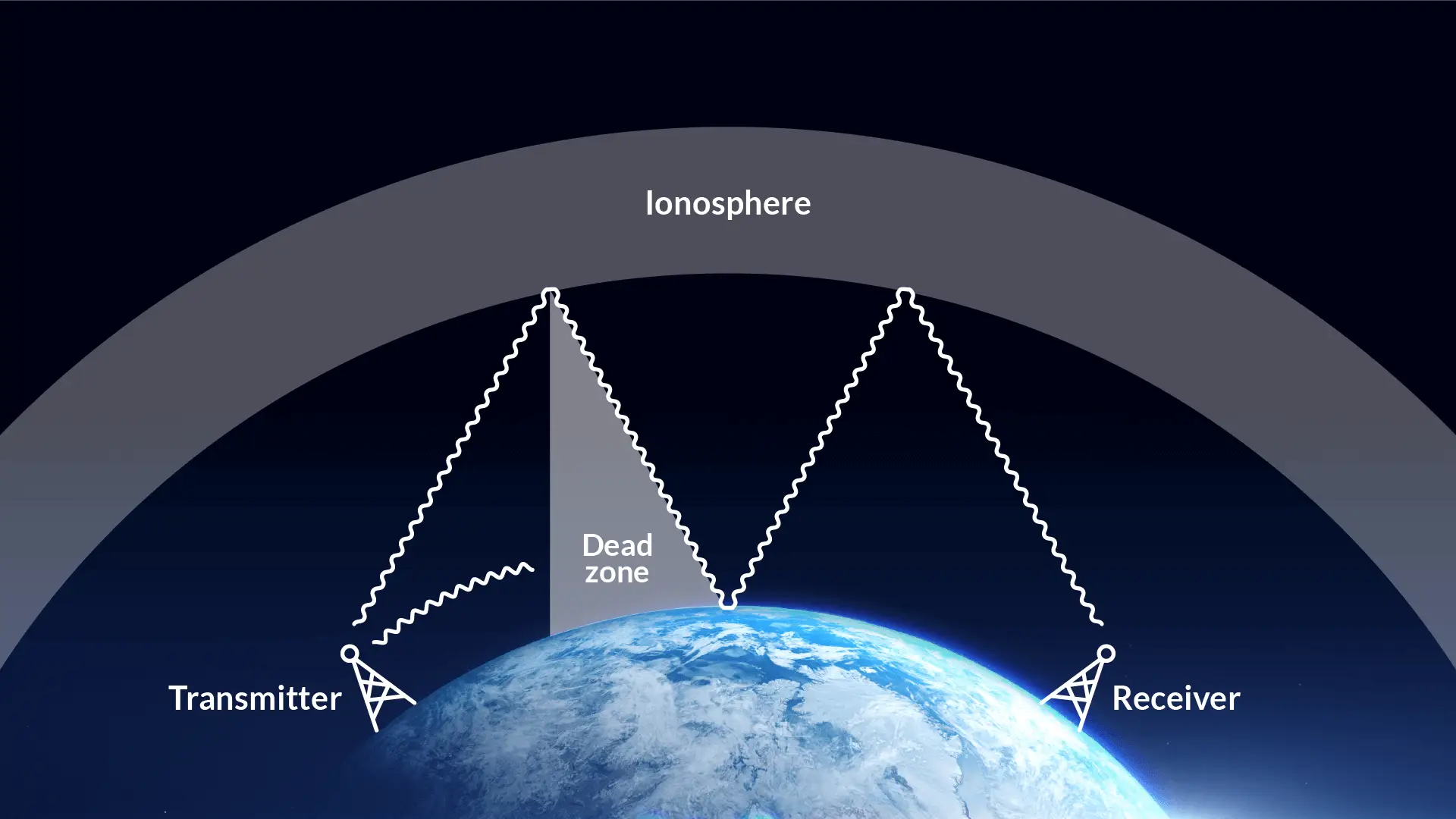
The Antenna and Everything Around It
For many users, antenna technology is comparable to black magic. But it’s not that complicated if you follow a few basic rules.
Antennas are distinguished between directional antennas and omnidirectional antennas. With directional antennas, the design ensures that the electromagnetic field is shaped (bundled) in a specific direction. Even when talking about antenna gain, an antenna does not generate more energy than is put into it. The energy is just bundled in a particular direction. An omnidirectional antenna, on the other hand, distributes all energy evenly all around. Now, one cannot say that one design is better than the other – it depends on what you want to do.
An omnidirectional antenna is better suited if I want to reach my friends distributed around my location equally. This doesn’t mean that long-distance connections aren’t possible with it. They are, just less frequently and with greater difficulties.
A directional antenna, however, helps with long distances – but only in a specific direction. This means that for maximum flexibility, I must set up the antenna to be rotatable. Depending on the size of the antenna, this can be very elaborate. After all, the antenna and the mast must also withstand a storm.
How to Get the Maximum Out of Your Antenna
Generally, you can follow some antenna construction rules that ensure better range.
The antenna should be as high and free-standing as possible. So better on the roof of the house, and if the house is on a hill – all the better. It’s good if there are no large, solid obstacles near the antenna. So preferably above the storage building with metal walls, and anyway far away from all electrical lines, metal fences, etc.
Get More Out of It With the Right Cable
The cable to the antenna should be as short as possible and as long as necessary. So rather a longer cable if I can get to a much better location. A cable that’s only 1 meter long is of no use to me if the antenna is in the basement.
The cable should be of good quality and not too thin. Thin cables have a much higher attenuation, which is more noticeable in the reception field strength than in transmission. Good cables have double shielding, which not only helps against interference in other TVs but also protects me from disturbances from the neighborhood. And you shouldn’t skimp on connectors either; there are significant quality differences here. If you have no experience in mounting coaxial connectors, investing in a good cable service with installation is certainly well-spent.
How Your Antenna System Remains Reliable
And the antenna mast and grounding must also be done properly; this is about your own safety. Finally, it should be noted that a regular inspection of the antenna system, about once a year, is very useful and can protect against unexpected disturbances. Many a corroded cable connection has caused strong noise. Directly at the antenna, this can often completely overlay the useful signal.
In the Long Run, Only Power Helps?
Yes, dear transmitting power. Many radio operators keep eyeing the big “burner,” a large transmitting amplifier with high output power. We can quickly address the legal aspect: In Germany, depending on the CB channel and modulation, between 4 and 12 watts are permitted. There’s also a distinction in how the power is measured, PEP or ERP. More on that shortly. In other words – any higher power is not permitted, even though it would be very helpful for better range.
Apart from the legal aspect, physics also sets simple limits. There are always situations where a lot of power hardly helps. If the terrain is unfavorable, even with 1000 watts, I won’t reach the neighboring valley in the mountains. And if there are no propagation conditions, I can’t create any even with an “afterburner” – the distant country remains unreachable. But with good conditions, just a few legal watts will do the job.
There are other aspects to consider when using an amplifier. Interference with neighbors is much more likely, the devices are large and heavy, you need good cooling, etc.
In summary – yes, more transmitting power is helpful in certain situations and increases the chance of reliable communication. But high power is not a cure-all, quite apart from whether it’s allowed or not. The legislator has set the power limits for good reasons, so mutual interference can be largely avoided.
Why SSB Maximizes Range
Does modulation really influence range? Yes, and how! In CB radio, three different types of modulation are used for voice communications (not digital data): AM, FM, and SSB. Without going into detail – SSB is the modulation that promises the most range. This is due to the required bandwidth (2.4 kHz for SSB compared to 6 or 10 kHz for AM and FM). A narrower bandwidth, however, also means lower voice quality, but that’s the price you have to pay. Compared to AM, all the power is concentrated in a quarter of the bandwidth, clearly reaching further. And compared to FM, the ratio is even more favorable for SSB. However, you lose the fabulous voice quality and the reduced interference of FM.
SSB is therefore the better choice for “DX” traffic (long-distance). Which doesn’t mean that AM or FM can’t sometimes reach thousands of kilometers as well. This is simply because the influence of good propagation conditions is much greater than the influence of modulation.
Plenty of Power – But Is Anyone Listening?
In every area of radio technology, there are the “crocodiles” – big mouth, but small ears. In other words – very high transmitting power, but the receiver is “deaf.” Of course, the receiver sensitivity and performance must be adapted to the power. What good is it if I can be heard well in Argentina but can’t receive signals from there?
Today’s CB radios generally have good receivers in terms of sensitivity and AGC control. And the actual sensitivity can hardly be influenced, only occasionally checked. It may happen that the receiver input is destroyed by a nearby lightning discharge, significantly reducing sensitivity. There are preamplifiers, but due to their high inherent noise and an overdriven receiver input, they cause more harm than good.
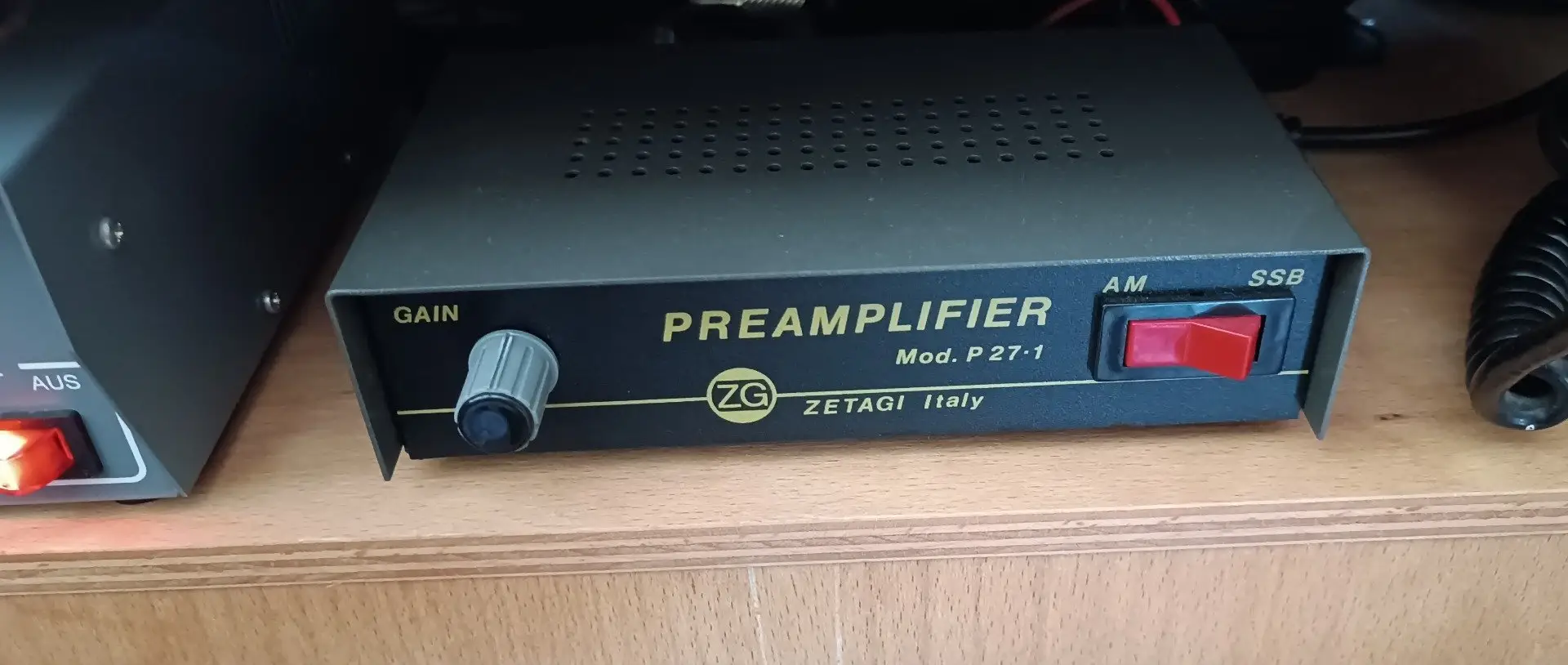
Differences in reception exist with additional devices such as noise reduction and the noise blanker. If the radio doesn’t offer this directly, additional devices like filters from bhi, for example, can help. And the position of the antenna is also highly influential, for example, if it’s located near sources of interference like a power line.
With the Right Information for the Best Range
Good range depends on many factors, some of which we can influence.
- A good directional antenna provides more range than an omnidirectional antenna – but only in one direction.
- More power provides more range – if legally permitted. There are radios with 12 watts of transmitting power and those with 4 watts.
- A good antenna location helps a lot – if the cable doesn’t have to be excessively long.
- A good cable always helps – without any ifs and buts.
- Good propagation conditions are the most important factor, but we can’t influence those. However, we can inform ourselves about what the conditions are and how they might develop in the coming hours and days.
